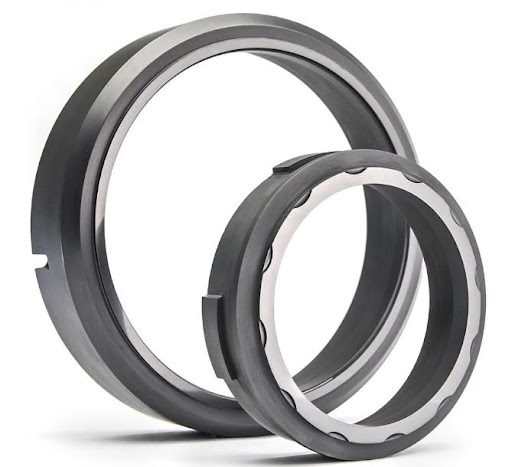Common Mechanical Seal Face Failures and How To Prevent Them
When industrial mechanical seal faces fail, production comes to a grinding halt, resulting in costly downtime, product loss, and potential safety hazards. While complete seal assemblies involve multiple components, the seal faces themselves are often the first line of defense—and the first point of failure.
To protect the integrity of these components, let’s first examine the root causes of seal failure and then outline comprehensive prevention measures.
Understanding Seal Face Failure Modes
Thermal Cracking
Manifesting in multiple fine cracks that resemble webs across the seal face, this destructive failure mode occurs when the seal interface is inadequately lubricated. Metal-to-metal contact generates intense frictional heat when the lubricating film breaks down. As a result, the seals generate excessive heat that triggers rapid material expansion and contraction.
This issue is particularly challenging with hard seal face materials. For example, silicon carbide and tungsten carbide exhibit excellent wear resistance but can be brittle under thermal stress.
Mechanical Wear
Seal faces are prone to degrading over time and form distinctive wear patterns. Each pattern indicates potential issues with your operating conditions, enabling you to address them before the seals fail. These include:
- Concentric grooves or tracking marks indicate abrasive wear from solid particles in the process fluid.
- Pitting or cavitation damage that appears as small craters on the seal face surface. This is often the result of chemical attacks or the collapse of vapor bubbles.
- Glazing or burnishing that creates a mirror-like finish indicates excessive heat and inadequate lubrication.
- Radial cracking emanating from the center suggests that mechanical stress may have resulted from incorrect installation or thermal shock.
- Chipping at the outer edges, which often points to handling damage or foreign object impact during assembly.
Contamination Damage
Contamination is another cause of premature seal face failure. Process fluids that crystallize, polymerize, or carry suspended solids can wreak havoc on even the most robust seal designs.
In chemical processing, product crystallization between seal faces creates a grinding compound that accelerates wear exponentially. Similarly, polymer buildup interferes with seal face contact, leading to leakage and subsequent thermal damage. In slurry applications, even small amounts of abrasive particles can reduce seal life from years to months or even weeks.
Installation Errors
Even the highest-quality seal faces fail prematurely if installed inaccurately. Misalignment between the rotating and stationary faces creates uneven loading, resulting in localized hot spots and accelerated wear.
Another error during installation is excessive compression, which causes immediate cracking and creates residual stresses that lead to premature failure. Additionally, surface contamination from handling introduces oils, dust, or particles that can act as abrasives or diminish lubrication.
General Prevention Practices
Now that we have clarified the causes of seal failure modes, let’s explore how to prevent them. Protecting seal faces effectively requires applying solid maintenance. Below are some essential practices to establish:
- Establish a robust preventive maintenance program as your first line of defense. Set baseline performance metrics, including seal chamber temperature, leakage rates, vibration signatures, and flush system parameters. Implement regular inspection schedules based on your operating conditions—high-temperature, abrasive, or corrosive services require more frequent monitoring.
- Invest in condition monitoring technology where appropriate. Infrared temperature sensors, acoustic emission detectors, and vibration analysis can identify developing problems before they escalate and fail. For critical services, consider dual seals with barrier fluid systems that provide early warning capabilities.
- Document everything. During planned shutdowns, inspect seal faces for early signs of wear and tear. Photograph and measure findings to track degradation rates over time. This historical data helps predict when seals will need replacement, allowing proactive rather than reactive maintenance.
- Train your maintenance personnel on proper seal handling, installation procedures, and troubleshooting techniques to ensure optimal performance. Many seal failures are preventable with the right knowledge and attention to detail.
- Observe installation best practices. Always use the appropriate tools for seal alignment and compression. Follow the manufacturer’s recommendations for shaft runout, perpendicularity, and torque. More importantly, always use clean, lint-free gloves when handling seal faces. The surfaces must be clean and free from contamination before assembly.
Problem-Specific Preventive Measures
Beyond standard maintenance, different failure modes require targeted prevention approaches. For thermal cracking, the strategies must focus on proper cooling and lubrication:
- Ensure your seal flush system operates at the correct flow rate and temperature. For high-temperature applications, consider implementing external cooling or pressurized barrier fluid systems to maintain optimal performance.
- Monitor seal chamber temperatures regularly and investigate immediately if temperatures exceed design specifications. Installing temperature sensors near the seal faces helps in quickly detecting and addressing lubrication breakdown. Set alarm thresholds that trigger investigation before damage occurs.
- Always ensure the seals are well-lubricated, the flush lines aren’t blocked, the flow rates meet specifications, and the flush fluid is suitable for your operating conditions.
When it comes to contamination, the focus of prevention tactics is on controlling flush fluid conditions. Here are critical steps to take and service-specific tips:
- Implement flush plans based on your service conditions. For instance, recirculation from pump discharge is suitable for clean fluids; however, some services may require the injection of an external lubricant.
- Install cyclone separators or filters in your flush lines to remove particulates before they reach the seal faces. Size these systems appropriately and clean and maintain them regularly.
- For industrial crystallization services, maintain a flush fluid temperature above the crystallization point and ensure adequate flow velocity to prevent buildup. Consider heated seal chambers or steam tracing in cold environments. Regular flushing during shutdowns thwarts the formation of hardened deposits.
- In polymerizing applications, maintain proper inhibitor concentrations in the flush fluid and avoid dead spots where polymer can accumulate. Some operations benefit from periodic solvent flushes to remove buildup before it becomes problematic.
Take the Comprehensive Approach to Protecting Your Seals
Industrial mechanical seal face failures often result from unsuitable operating conditions, improper installation, or inadequate maintenance. Addressing them involves understanding the root causes, establishing strong maintenance practices, and implementing strategies for specific challenges.
Remember: the goal isn’t just to replace failed seals quickly, but to understand why they failed and prevent recurrence in the future. With proper knowledge and proactive maintenance, you can dramatically extend seal life and keep your operations running smoothly.

















